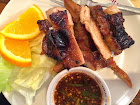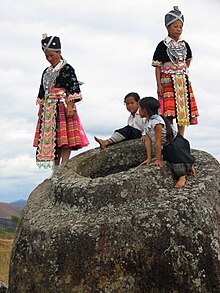Which is a bit of an exaggeration. A Lao prince named Fa Ngum, founded the Lan Xang Kingdom in the 14th century. Lan Xang translates into " a million elephants" - a deliberate name for his kingdom to inspire fear amongst his enemies at a time when elephants were the principal engines of war.
Laos has a brutal and bloody past. Landlocked between Myanmar (Burma), Thailand (Siam), Cambodia, Vietnam and China, it was never going to have it easy. It fell to Burma and to Thailand, but the Lan Xang Kingdom recovered when Sourigna Vongsa ascended to the throne in 1637. Europeans first reached the capital Vientiane in the late1600's, and Dutch merchants returned with admiring descriptions of a prosperous kingdom: the most beautiful city in Southeast Asia - a place of palaces and temples, and awe-inspiring religious ceremonies. In 1893 it became a French protectorate. It gained brief independence after Japanese invasion in 1945, but returned to French rule until it again became a sovereign monarchy in 1953. Shortly after independence, a long civil war ended the monarchy when the Communist Pathet Lao Movement took power in 1975. Today Laos is a single party communist state which espouses Marxism. It is one of the poorest countries on the planet, with a third of the population living in poverty or extreme poverty. It ranks very low on the Human Development Index, and very high on the Global Hunger Index. And since we are ranking things, I can now categorically state that Lao food ranks first on our list of most spicy food ....or that was our experience anyway.
There is a Southeast Asian wisdom which purports that eating really hot and spicy food actually helps to cool you down. As you sit there perspiring from every possible pore on your body, the evaporation of the sweat acts like a natural air-conditioning unit. Well, the science did not work last night. Nevertheless, it did not distract from the enjoyment of the fresh, healthy and anything-but-bland Lao food.
So what differentiates Lao cuisine from it's neighbours? Firstly, Laos is the home of sticky rice. They even refer to themselves as "luk khao niaow" , or children/descendants of sticky rice. Their eating utensil is their left hand. Sticky rice is much easier to roll into a ball and dip into a sauce than fluffy steamed rice. This is why food is eaten at room temperature. For the same reason, the curries are dry, unlike Thai curries (more soup-like) rich in coconut cream. With 60% of the population living on the banks of the Mekong river, steamed or grilled fish with fresh herbs form a staple. One of the most distinctive and unique Lao food is Padek , fish rubbed with salt and preserved for up to 3 years. Their traditional dish laap or larb consists of minced chicken or pork which is boiled and then served with sticky rice and raw vegetables (undressed). Nothing is fried, rather grilled and steamed. Sticky rice is steamed and served in a bamboo basket (huad) with every meal. Laotians prefer their food savoury, and dishes are never sweet. They find the concept of sweet and sour completely bizarre. Another distinguishing factor is their preference for bitter food. They have a saying "van pen lom; khom pen ya" which basically means "sweet makes you dizzy; bitter makes you healthy".
A meal will typically include a soup, a grilled dish (like fish) and laap. These are not served in sequence, but all together and it is perfectly acceptable to sip at your soup throughout the meal. To indicate that you have finished eating, you close the rice basket (haud). The flavours of Laos are aromatic and fresh: Lao basil, galangal, garlic, coriander, climbing wattle, bamboo shoots, lemongrass, lime, mint, tamarind and chili. They also love kaipen, which is dried Mekong algae (similar to Japanese nori).
There were six of us experimenting with the foreign flavours and techniques of Lao food last night. You can pre-determine the level of spiciness of your meal. Louise and Finn were happy with a mild introduction; Phil, Keith and I decided on a medium approach and Andrew G bravely embraced the full-blown cultural assault. At this stage, of course, we had no idea what the Lao interpretation of mild, medium and hot was....
Thai Wi Rat is located in the China Town Mall in Fortitude Valley, 1km from the CBD. It is one of only three restaurants in Brisbane that serves authentic Lao cuisine. Despite the immediate discomfort of the chili heat, I thoroughly enjoyed my Tom Sam (green papaya) salad and pork laap. Keith said his dish was unlike anything he has tasted before. Phil (stunned into silence) nodded in agreement. Louise and Finn (the sensible two) both enjoyed their food, and Andrew G is still endeavouring to defuse his tastebuds. All-in-all a most fascinating Friday Night Out. To enhance our experience, what other than the sharing of facts?: We all contributed to the fact that Laos is the world's most bombed country in the world, with 2 billion tons of ordnance (262 million cluster bombs) dropped during the Vietnam war. This is a huge problem, as there are large quantities of UXO's (unexploded ordnance) littering potential farmland. Keith expanded by mentioning that many bombs landed on The Plain of Jars - an archaeological landscape dating back to 500BC claimed to be associated with pre-historic burial practices. There are 90 jar sites, with the number of hand carved stone jars varying from 1 to 400 at each site. The evidence of bomb raids can be witnessed, with displaced jars and bomb craters.
Andrew G informed us ( while wiping perspiration from his brow) that even though Laos has no coastline, it is home to the unique Irrawaddy Dolphin resident in the Mekong river.
Finn shared the tricks of rhino beetle wrestling - a betting game popular in Laos.
Louise again had a textile fact handy, explaining how woman are empowered through craft groups and garment-making, weaving beautiful fabrics from handpicked and -spun cotton.
Keith jumped in with another fact (very keen last night) that the national flower is the champa. The rest of us thought it looked just like an ordinary frangipani!
And then Phil read a couple of paragraphs from a book written by his uncle, who served as a diplomat in Laos during the Vietnam War, relating first hand impressions, not only about the place and the people, but also the resulting effect of partaking in an opium ritual.
Still a place of huge mystique, Vientiane with it's golden spires of Buddhist temples, decrepit French villas and art deco Russian buildings manages to maintain the fine balance between the Buddhist calm and the new ambitious growth experienced in the capital. A destination well worth exploring.






There are more Lao people living outside of Laos than within, most of them in Thailand, The United States and France. Australia is home to 22,303 Laotians, with 1,316 living in Brisbane.
Next week we stay in Asia....Taiwanese anyone?


No comments:
Post a Comment